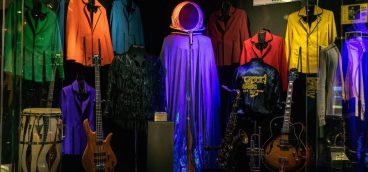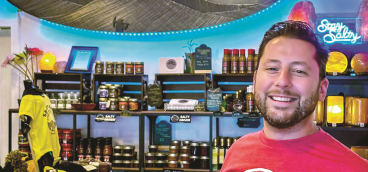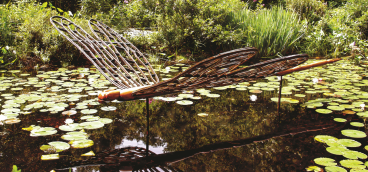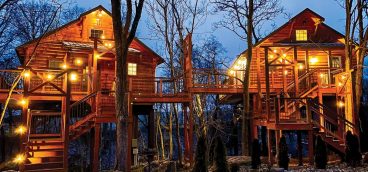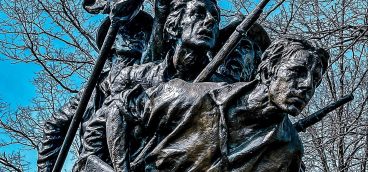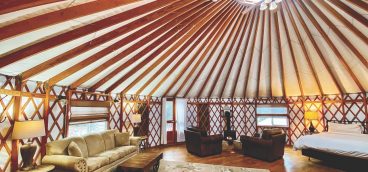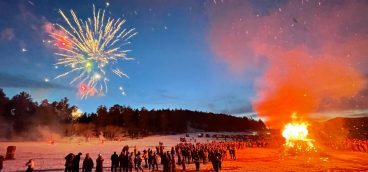First Cruise, Last Continent: A Voyage to Antarctica
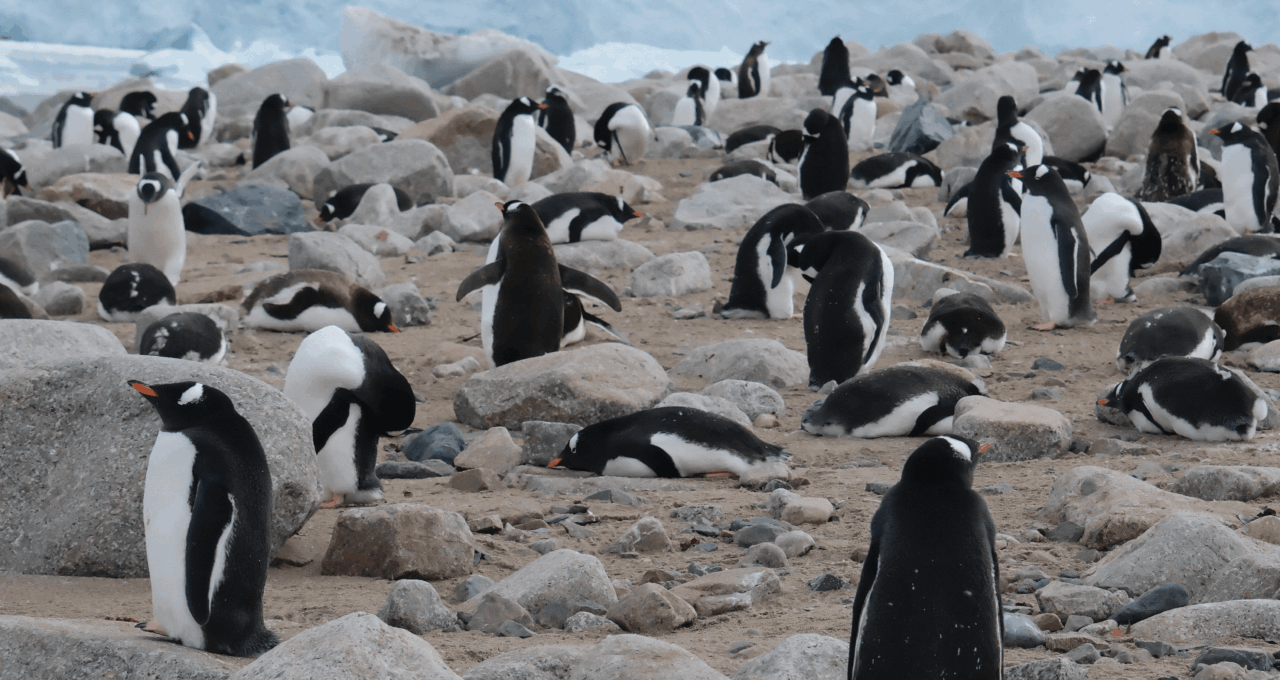
There is a language for ice. Tabulas are broad, flat-topped icebergs, and growlers are smaller bergs under three feet tall. Brash ice is a collection of floating discs that form mesmerizing patterns in the water. Then there are the bergy bits, a name that sounds like an offering from a fast-food outlet but denotes chunks of ice that can be the size of a small house.
Some icebergs are as vast as islands, while other behemoths dwarf the 10-deck cruise ship I was on for 12 days — my first cruise ever — to my last continent visited, Antarctica.
I confess I was more apprehensive about this trip than any other, for two reasons: one was forging through the notorious Drake Passage, the most turbulent spot on the planet, where the Antarctic circumpolar current gets free rein in the open seas. It’s also where the Atlantic, Southern and Pacific oceans meet, sometimes like a family reunion gone bad: All hell breaks loose. And it takes two days by ship to cross the unpredictable, 600-plus-mile stretch.
Reason number two is my fear of falling on ice that stems from walking big dogs on wintry Pittsburgh sidewalks.
Also, I get seasick.
Good bet for a cruise to Antarctica, yes? And yet, there I was, with a gung-ho husband eager to do the famed Polar Plunge, and two spirited friends who brought every kind of seasick pill and patch available.

Good thing, because fear number one came into play shortly after boarding our sleek, super-yacht of a ship, the Scenic Eclipse, in Ushuaia, the capital of Tierra del Fuego, Argentina.
Within hours, the suave captain called us to our first meeting in the elegant theater, with its plush swivel seats and starry ceiling, for an important announcement.
Unfortunately, he said, we would be waylaid awaiting a storm with nine-meter swells (over 30 feet) and winds up to 60 knots (nearly 70 mph) in the Drake Passage.
On the big screen, the weather map was a giant blob of violent red and purple that stretched from the tip of Argentina to the Shetland Islands.
Holy bergy bits.
Plan B, said the captain, was to advance through the 150-mile-long Beagle Channel that juts out from Argentina, and then drop anchor to wait out the storm.
Luckily, the Beagle Channel is quite scenic, with snow-shrouded peaks and mighty glaciers, providing a tantalizing trailer for the main feature to follow.
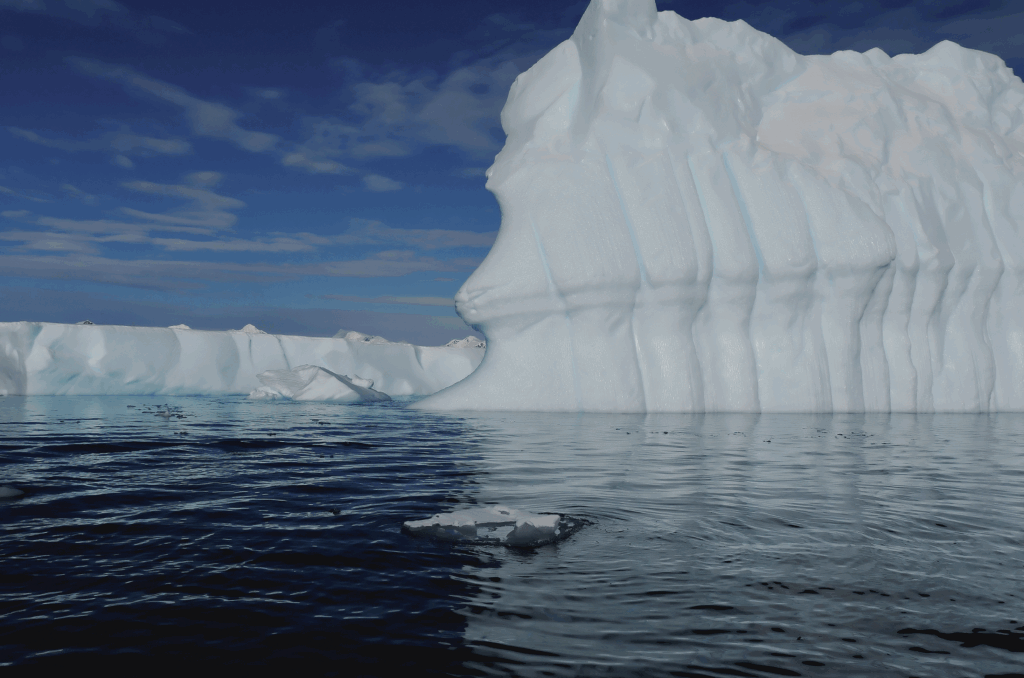
We hunkered down while we got acquainted with the small luxe ship. From its elegant hotel lobby of a lounge to the charming library/tearoom overlooking the ship’s graceful bow, there was nothing not to love.
To get up to speed on cruising, we attended lectures on topics such as kayak safety and leave-no-trace guidelines, signed up for the helicopter ride and kayaking, and got fitted for our muck boots. We even participated in the daily trivia at happy hour, teaming with fun new friends from (of all places), Mars, Pennsylvania, who brought a Terrible Towel.
We also visited the captain and crew on the bridge, aka the command center, which was open to passengers. Fascinated by the many charts on digital display, we noted that the highest wave in the Drake the first day was over 10 meters, or 32 feet. We’ll set out when the waves are close to six meters, said the first mate.
And we did, leaving at 6 o’clock in the morning. Within hours, we experienced the dreaded Drake Shake (as opposed to the more desirable Drake Lake effect) with wild rolling swells that sometimes smacked the sides of the ship as high as the fourth deck.
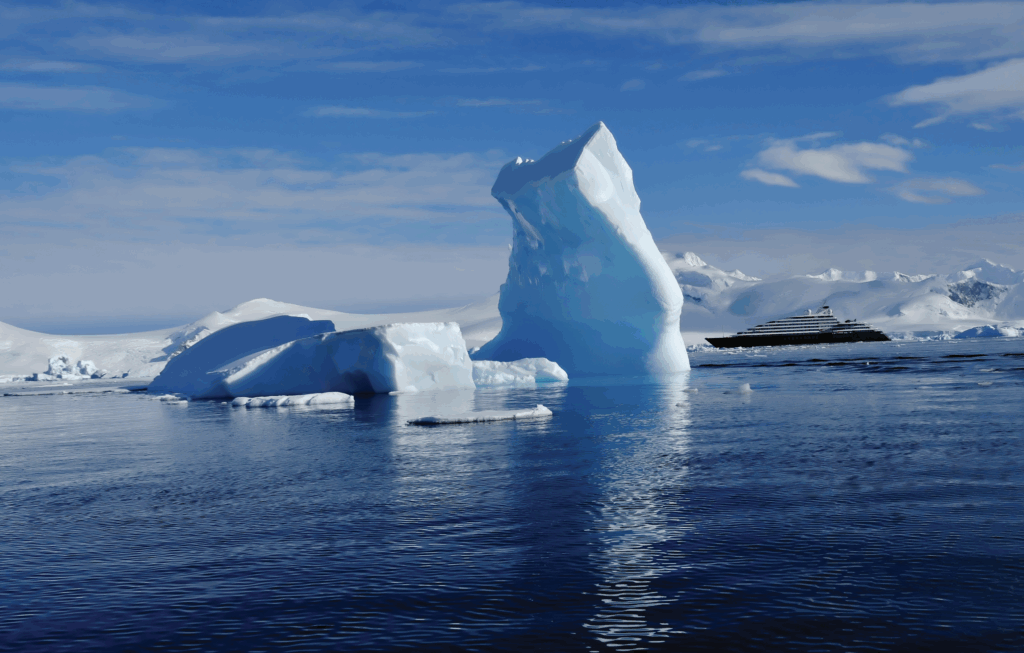
The good news: The Scopolamine patch we applied the night before worked its magic. None of our group of four was sick and we even worked out in the gym, hit the spa and enjoyed meals without coffee spilling from cups or spoons flying from plates. Walking was the hardest part, but handrails saved us.
It helped that our ship had stabilizers, 18-foot-long fin-like appendages on either side of the bottom. It was one reason we chose this cruise. The other: Only 100 people at any time are allowed to be on land at any stop, so we would get more time to explore with only 183 passengers on board. Also, a smaller ship like ours can maneuver about anywhere on the peninsula but large ships are limited.
By the second day, the Drake was less rough but still rocking. We saw our first distant iceberg, a small one that provided an outsized thrill.
The next morning, while we were still in bed, the captain announced our arrival in Antarctica.
I opened the floor-to-ceiling blinds to catch our first misty glimpse of the peninsula with icebergs looming close to the ship and white mountains beyond. We dressed in a rush to get to breakfast and gawked at the 180-degree view.
At 10 a.m., we headed down with our assigned small group to the third deck muck room and donned long rubber boots, a necessity for every outing. Bundled to the max, we boarded the small, inflatable Zodiac with the help of the efficient crew. I gripped the attached rope (cue fear of falling) as we zipped away on the icy sea.
From the minute I sat at the hard-rubber edge, just a foot above the water, I felt a tiny part of the vast wintry universe.
As we approached our first stop at Mikkelson Harbor, we saw hundreds of gentoo penguins come into slow focus, scampering hither and yon over the hillside and pebbly beach. It was magical.
We were cautioned to stay on the path, marked by orange flags planted earlier by our guides, and to get no more than a van’s-length-close to any wildlife.
Of course, no one informed the chatty penguins. Adults and babies fearlessly waddled up to us on their way to everywhere and nowhere. We stopped in our tracks, giving them the right of way and resisting the urge to hug one.
We trekked an icy hill and were rewarded with a magnificent view: Snowy mountains looming over a vast, blue-tipped ice wall and inky seas. In the foreground were penguins, so many adorable and flightless birds scooting about on their guano-marked hill.
They’re a blast to watch and photograph. Like us, they are clumsy on ice. But if they start to fall downhill, they lean into it, gliding on their ample bellies and skidding to a practiced stop. It was a trick I wanted to try for myself as I inched my way down the hill too slowly, not trusting the ice. But I made it, as did all the others, without incident.

On our next excursion, at Danko Island, we were given poles that helped, planting them in the crunchy snow as we (more confidently) made our way. There we saw dozens of gentoo penguins scattered among the bones of a whale skeleton and beyond.
When we stopped at Damoy Point, home of the Ukrainian research center, the ice was unforgiving. My poles didn’t crack the surface layer but they somehow managed to keep me upright. Every time, the view from the high point on land was worth the trek.
My fear of falling on ice waned while my joy of exploring on land soared.
We lucked out with the wind, which we encountered infrequently. We were often in protected bays, at the whim of the captain and crew, who did their best to find the optimal spots given the current conditions.
We also got lucky with several blue-sky days, a rarity for Antarctica skies, which are typically thick with clouds. The first few days, the temps were warmer than those in Pittsburgh (mid-30s for a high, compared to mid-20s back home). The last few days it was the reverse, but we were prepared with double-layered parkas provided by the cruise line.
The only part of me that ever got frosty were my hands, from stripping my gloves and photographing. And there was plenty of opportunity for that.
The South Atlantic Sea is chockablock with icebergs in all shapes and sizes. One looked like a lunging polar bear and another like a long ship. Some were tall and sculptural as if carved by an artist’s hand, marked by that wondrous shade of azure that our Russian guide, Larissa, dubbed “Gatorade blue.” We saw more than one solid white iceberg cast a vivid blue shadow in the water.
Then there was the added spectacle of seals languishing on floes or penguins cavorting on the ice or giant albatross gliding overhead.
Does it ever get old, someone asked a guide. It’s always changing, he said. Every day, every trip.
From the start, our foursome loved the twice-daily excursions and didn’t miss one, gearing up and making our way to the muck room and returning on a high one to three hours later.
If we explored on land, the crew hosed off our muck boots before we stepped into a small vat of soapy water and returned to the ship’s interior.
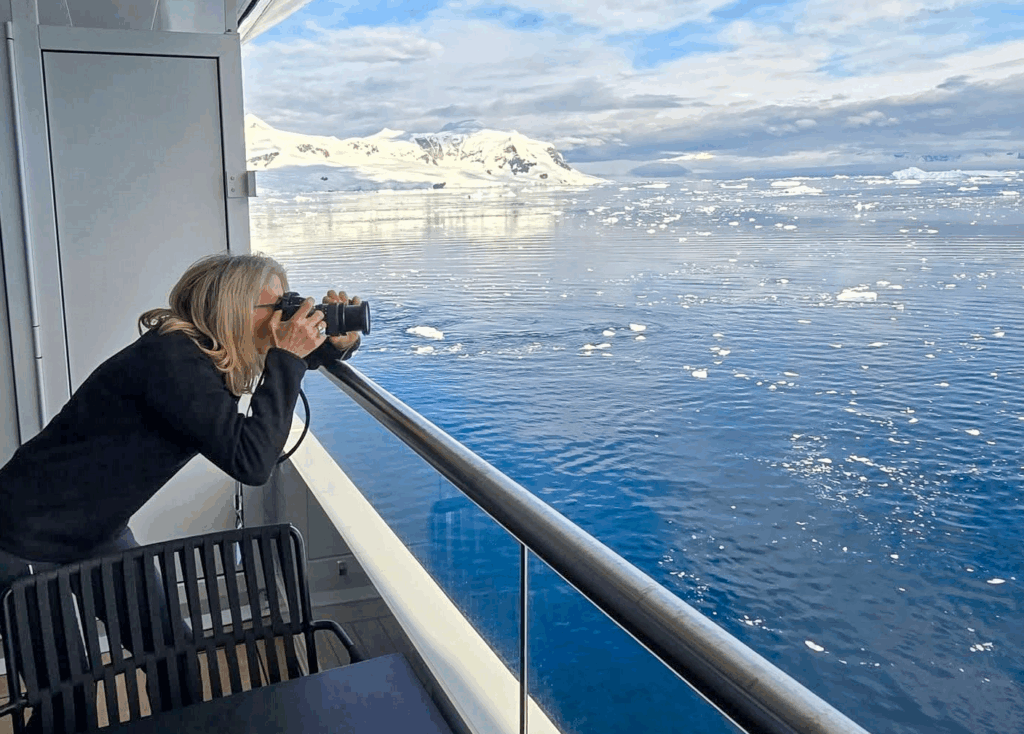
At night we closed the blackout blind, a necessity in the Antarctic summer, December through February, when there are only a few hours of darkness. Once we crossed the Antarctic Circle, with an exuberant announcement by the captain, we experienced 24 hours of daylight — a first and very likely a last.
Throughout the trip, the captain adeptly positioned the boat so we could capture a spectacular scene daily, as if the ship were a camera and we were witnessing the perfectly framed photos from our window lens.
The many textures of Antarctica unfolded at every turn: glossy seas, glistening ice, shimmering floes and chunky bergs against a backdrop of whipped-cream snow that thickly covered mountains of many sizes.
Kayaking was its own form of magic. Nick and I shared a tandem, weaving through chucks of ice, watching crabeater seals snoozing on floes, and gawking at groups of gentoo penguins rising from the water as they swam by in a flash.
On one Zodiac excursion we were chased by a large leopard seal, who kept zooming in to peer up at us. Throughout, we spotted minke whales, the smallest of baleen whales at around nine feet, and humpback whales spouting and flashing their flukes before dipping below the surface.
We missed the pod of orca whales that a group witnessed as they surrounded a poor seal on a floe. The five whales cracked the ice from below and then created a wave of water that forced the seal off the ice.
Many of us watched with envy from the ship, binoculars in hand. At the nightly captain’s briefing before dinner, the guide Esteban emphasized the rare sighting of such an attack and showed off his amazing close-up whale photos.
He was the same guide who cut the motor on our Zodiac on one outing to scoop up a chunk of shimmering ice “10,000 years old,” which he then chopped into bite-sized bits for us to sample. Best ice ever.
I had a different perspective of ice as I faced the 32-degree waters for the Polar Plunge. Eighty-two thrill seekers lined the deck in identical grey robes, cheering as they waited for their turn. It was a party scene, with an outdoor bar and Van Halen’s “Jump” playing loudly.
Nick and I angled to be the first pair to get it over with more quickly. With ropes around our waists, we counted with the crew: one, two, three!
Holy guano. It was frigid being fully immersed. Focused on getting the heck out of the water, my limbs seemed suddenly heavy and I plowed instead of swam to the ladder yards away.
Turns out that’s what happens when mere humans try to swim in temps meant for seals and penguins: Your system goes into a shock of sorts and you slow down in response. (Note to crew: This would be good to know in advance. A trivia question, perhaps, replacing the “What year was the CD invented?” one that we missed.)
In any case, the plunge was over in minutes, and we enjoyed the spiked hot chocolate that followed, along with our self-declared hot tub plunge that lasted much, much longer.
Beyond this legendary activity, there was a special celebration for those who made it to their seventh continent. We toasted with a drink the color of ice blue and congratulated others who had traveled the world.
The bartender, Armand, the most popular guy on the ship, told us each day would be better than the next — and he was right. Our last day was the best, in a fireworks-finale of a setting called Winter Island, ringed by steep snowy mountains and the most impressive display of ice yet. This is where our group of four boarded the helicopter and saw the spectacle of ice from above, a 30-minute ride that none of us would have missed. (Sadly, the submersible was not operating during our cruise.)
Later, visiting the bridge, I asked the captain if we would make it through the Lemaire Passage, which we skipped on the way down because it was choked with ice.
Everyone talks about the Lemaire Passage, said the captain a tad defensively, but where I took you today is far better.
He was correct, but the Lemaire Passage was still a thrill. At its narrowest, it is only 2,000 feet across, and it’s nearly eight miles long with all kinds of ice in various configurations.
Dozens of passengers and a good many of the crew lined the bow to see mountains squeeze in on both sides as we approached the entrance. Every so often, a boom came from below, a thud of hull scraping ice. Sometimes it was more of a grind or muted clang, not to be confused with the ship’s bow thruster, which makes a growling and menacing noise of its own.
We were used to these noises by now, but not all at once. To punctuate the drama, we heard a thunderous rumbling and turned to witness an avalanche as a massive wall of snow peeled off from a concave mountain wall right in front of us.
We watched a ship approach from the other direction in the passage, tiny against a giant iceberg. Once it neared us, we saw that it was just as big as ours.
Easing our way very slowly through all seven-plus scenic miles was one of the best parts of the trip as we said goodbye, sadly, to Antarctica.
That night, we entered the Drake Passage with the captain’s assurance that things would be calmer this time. Ha! No such luck. By 11 p.m., the bed shook and rocked as the waves smacked the sides of the boat. This went on for hours, apparently, but I slept through it.
The sea calmed by the afternoon and we got to experience the Drake Lake for the rest of the trip. Honestly, I no longer cared. I had overcome my fears and was filled with a sea-deep gratitude that this First Cruise/Last Continent trip turned out to be the best, albeit priciest, of a lifetime. Our friends agreed.
In ways I can’t describe, I felt a significant shift inside me, and knew I was a different and somehow better person returning than the one who had departed 12 days earlier. Call it the Drake Wake.


